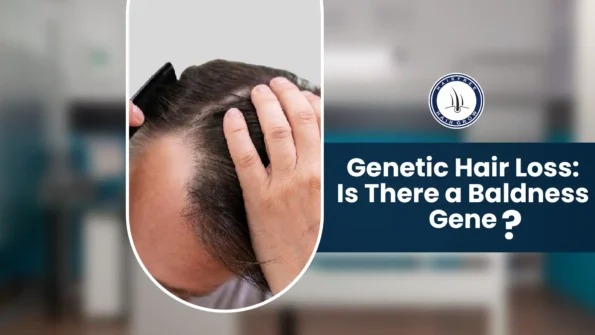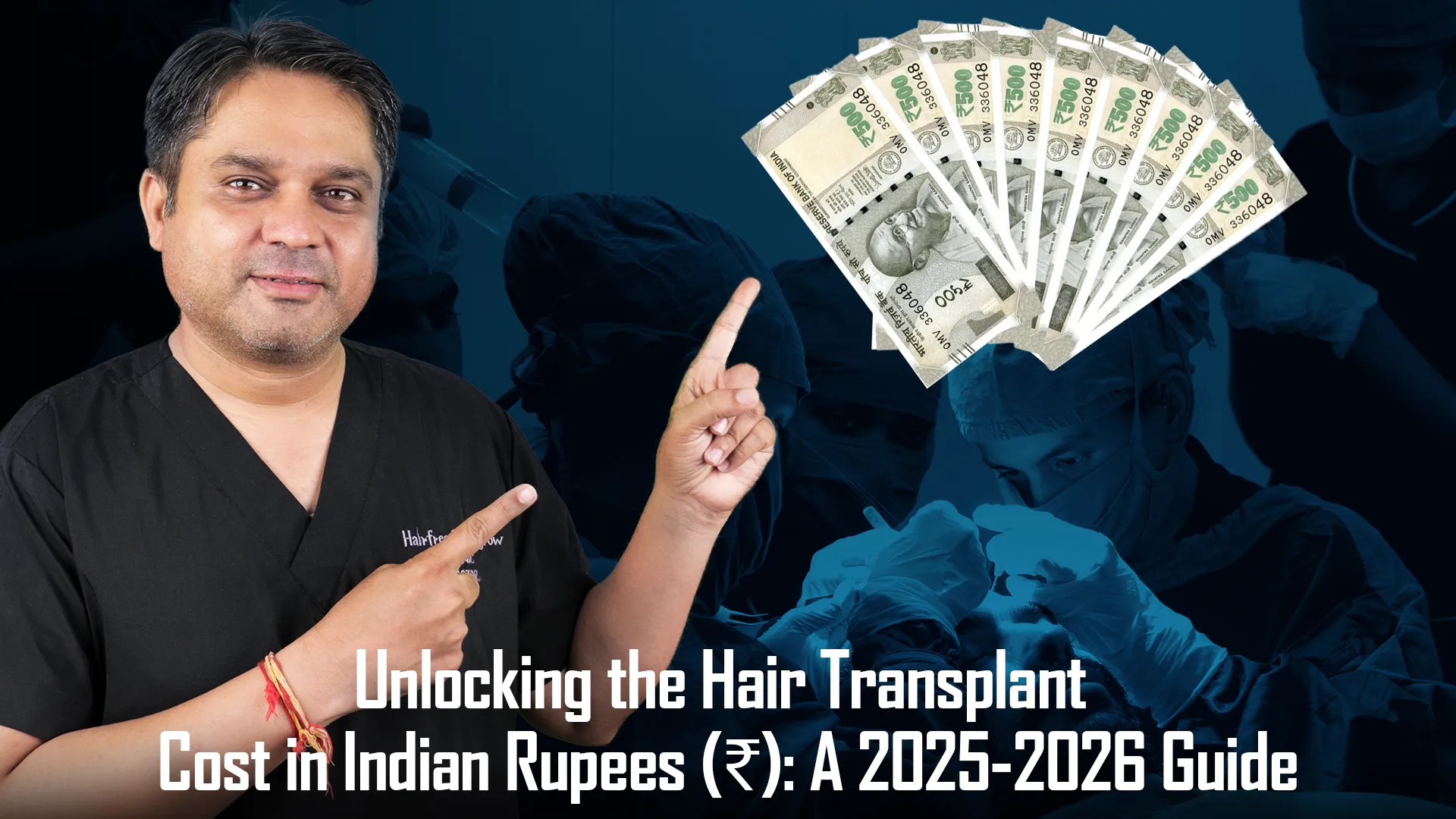Many people, young and old, men and women, worry about losing hair. It can be a real drag on your confidence. One of the most common reasons for hair thinning and baldness is Genetic Hair Loss. This is called androgenic alopecia.
We’ll explore the genes that can cause genetic hair loss, how it happens over time, and the different treatments available, both the kind your doctor might recommend and newer options.
About the Baldness Gene
Have you ever wondered why some people lose their hair while others keep a full head of hair well into old age? The answer lies largely in our genes. The “baldness gene” isn’t just one gene, but a combination of genetic factors that can make some people more likely to lose their hair as they get older.
This type of hair loss, often called male pattern baldness, runs in families. It’s not just about what you inherit from your dad, though. Your mom’s side of the family plays a big role too. These genes work together with hormones in your body, especially one called DHT, which can cause hair to thin and eventually stop growing.
While genes are a big part of the story, they’re not the whole picture. Things like stress, diet, and overall health can also affect hair loss. Understanding the baldness gene helps us see why hair loss happens and gives scientists clues about how to prevent or treat it in the future.
Male Pattern Baldness
Male pattern baldness, also known as androgenetic alopecia, is the most common type of hair loss in men. It typically follows a characteristic pattern: a receding hairline and thinning on the crown, often leading to a horseshoe-shaped ring of hair around the sides and back of the head. This condition affects many men at some point in their lives, with the likelihood increasing as they get older.
The pattern of hair loss in male pattern baldness is usually predictable. It often starts with a receding hairline at the temples, followed by thinning on the top of the head, which can cause partial or complete baldness. The speed and pattern of hair loss can vary greatly among individuals. Some men may experience rapid hair loss at a young age, while others might have only mild thinning later in life.
Currently, there is no cure for male pattern baldness, but there are several ways to slow down or treat hair loss in some men. These treatments include medications, such as minoxidil and finasteride, hair transplant surgery, and lifestyle changes to promote healthier hair.
Female Pattern Hair Loss
Female pattern hair loss, also known as androgenetic alopecia in women, is a common condition characterized by thinning hair, primarily on the top and crown of the scalp. Unlike male pattern baldness, female pattern hair loss usually involves a general thinning of the hair while maintaining the hairline.
The exact causes of female pattern hair loss are not completely understood. However, it is believed to be related to a combination of genetic and environmental factors. The role of androgens, which are male hormones present in smaller amounts in women, is also considered significant.
The onset and severity of female pattern hair loss can vary. It often begins after menopause, although it can start as early as puberty. The condition is characterized by a widening of the part and sometimes noticeable thinning at the crown. Unlike male pattern baldness, female hair loss rarely leads to complete baldness.
There are treatments available to help manage female pattern hair loss. These include topical treatments like minoxidil, oral medications, and lifestyle changes to promote hair health. In some cases, hair transplant surgery may also be an option.
| Feature | Male Pattern Baldness | Female Pattern Baldness |
| Pattern | Receding hairline, thinning crown, horseshoe pattern | General thinning, primarily on top and crown |
| Hairline | Recedes | Usually remains intact |
| Baldness | Can lead to complete baldness | Rarely leads to complete baldness |
Hair loss is incredibly common. It’s estimated that around 50 million men and 30 million women in the United States alone experience genetic hair loss. By age 50, approximately 50% of men and 25% of women will have noticeable hair loss.
Symptoms of Genetic Hair Loss
The symptoms of genetic hair loss can vary but typically include:
- Thinning on the Top of the Head: This is the most common type of hair loss, affecting both men and women as they age.
- Receding Hairline: Often seen in men, this starts as a receding hairline that gradually moves backward.
- Bald Spots: These can be patchy or circular and may spread over time.
- Widening Part: Women often notice a widening part or thinning around the crown.
- Shedding: You might see more hair than usual in your brush, shower drain, or on your pillow.
Genetic Hair Loss Treatment
Treatment involves a combination of medication, lifestyle changes, and in some cases, surgical options.
The most common treatments include:
1. Minoxidil (Rogaine)
Minoxidil is an over-the-counter topical medication that you apply directly to your scalp. It can stimulate hair growth and slow down hair loss. Many men find Minoxidil effective, but you need to use it continuously to maintain the results.
2. Finasteride (Propecia)
Finasteride is a prescription oral medication that works by blocking the hormone dihydrotestosterone (DHT). DHT is responsible for shrinking hair follicles. By reducing DHT levels, Finasteride can slow hair loss and even promote regrowth in some men.
3. Hair Transplant Surgery
Hair transplant surgery is a more permanent solution for restoring hair in balding areas. It involves moving hair follicles from the back and sides of your head to the balding spots. The results take about a year to become noticeable, though it may take longer for the crown area.
It is crucial to meet and get to know your doctor over time. Only when you feel comfortable should you proceed with a hair transplant? Additionally, always contact past patients of the clinic to verify their results. At HairFree HairGrow, we have over 15000 patients and have achieved the best success with all of them.
4. Low-Level Laser Therapy (LLLT)
LLLT devices, like laser combs and helmets, use laser light to stimulate the scalp and hair follicles, promoting hair growth. This non-invasive treatment can be done at home or in a clinic.
5. Scalp Micropigmentation (SMP)
SMP is a cosmetic procedure where tiny dots are tattooed on the scalp to mimic the look of short hair follicles. While it doesn’t treat hair loss, it can give the appearance of a fuller head of hair.
6. Healthy Lifestyle
Maintaining a healthy lifestyle can also support hair health. Eating a balanced diet, exercising regularly, and reducing stress can have a positive impact on your overall well-being and potentially benefit your hair.
Conclusion
Genetic hair loss is a multifaceted issue influenced by various genetic, hormonal, and lifestyle factors. While it can be distressing, understanding the causes and available treatments can empower individuals to manage and mitigate its effects. If you’re experiencing hair loss, consult with a healthcare provider to explore the best options tailored to your specific situation.
Genetic hair loss is a common condition affecting both men and women, with testosterone hormone playing a key role in hair follicle sensitivity and hair loss. Understanding the mechanism behind genetic hair loss is crucial for prevention and treatment.
- Visit any branch for your hair problem or call us at: +91-72 72 83 2222
- We are located in Surat, Pune (Pimple Gurav), Pune (Kharadi), Hyderabad, Ahmedabad, Kolkata, Indore, Bhopal, Delhi (Gurugram), Nagpur, Mumbai, Vapi (Silvassa), and Bangladesh.
Written By
MD (Skin & VD)
Dr. Santpal Sangwan is a renowned hair restoration specialist with expertise in Genetic Hair Loss. He provides personalized treatments to address hair thinning and baldness, helping patients achieve natural, lasting results through advanced medical solutions and compassionate care.
Disclaimer
We’ve made all possible efforts to ensure that the information provided here is accurate, up-to-date and complete, however, it should not be treated as a substitute for professional medical advice, diagnosis or treatment. See Detailed Disclaimers Here.





